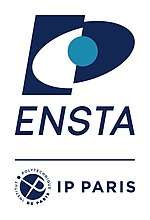ENSTA Paris
The ENSTA Paris, formerly known as the École nationale supérieure de techniques avancées (English: Superior National School of Advanced Techniques) is a prestigious French graduate school of engineering ("école d'ingénieurs"). Founded in 1741, it is the oldest "grande école" in France. It is located in Palaiseau in the south of Paris, on the Paris-Saclay campus, and is a constituent faculty of the Paris Institute of Technology (ParisTech). Every year some 180 engineers graduate from the school.
École Nationale Supérieure de Techniques Avancées | |
 | |
Former names | École Nationale Supérieure du Génie Maritime |
|---|---|
| Type | Public ; under military supervision |
| Established | 1741[1] |
| President | Elisabeth CREPON |
Academic staff | 180 permanent ; 650 temporary[2] |
| Students | 897 (2017)[3] |
| Postgraduates | 777 (2017) |
| 120 (2017) | |
| Location | , |
| Website | http://www.ensta-paris.fr |
ENSTA affords its students a general training course in engineering with the aim of enabling them to design and produce complex systems while meeting strict economic constraints. To this end, the school provides high-level scientific and technological training. The teaching is given by research professors with the participation of numerous auxiliary teachers from the economic and industrial world familiar with the latest technical developments in a wide variety of fields. The general nature of the training on offer enables ENSTA graduates to find a career in various sectors such as the automotive or naval industry, networks and telecommunications, space propulsion, robotics, oceanology and the environment.
Research, one of the school's primary missions, makes a significant contribution to both fundamental and applied fields, meeting the needs of businesses and also contributing to the school's scholarly outlook. Roughly half of the research at the school is the responsibility of the school's research professors, and the other half is carried out by researchers from the CNRS, the INSERM and the École polytechnique working at ENSTA premises.
History
Originally, the school was the brainchild of Henri-Louis Duhamel du Monceau, inspector general of the Navy. He had identified the need to give the Navy's master carpenters a theoretical education, particularly in mathematics and physics, which were making quick progress, so that they would have a clearer understanding of their trade.
Duhamel du Monceau founded the first school in his home in Paris on the Isle Saint Louis in 1741. This date is recognised as the origin of the institution. In 1748 it was moved to the royal library on rue Richelieu, and in 1753 to the Louvre Palace, immediately adjacent to the Académie des Sciences. It was closed in 1759 during the Seven Years' War. In 1765, he managed to persuade the duc de Choiseul to reopen it as part of a sweeping overhaul of the navy. Duhamel du Monceau continued to run the school for the rest of his life.
The School of Student Engineer Constructors, as it was known, was closed in 1793 during the French Revolution. It reopened in 1795 as an application school for the Ecole Polytechnique. Later on, it became known as Ecole nationale supérieure du Génie Maritime (National Higher College of Maritime Engineering).
In 1970, the Délégation Générale pour l'Armement (Arms administration of the Ministry of Defence) merged the school with three of its other establishments:
- the École Nationale Supérieure des Poudres (Powders and explosives institute)
- the École Nationale Supérieure de l'Armement (Arms engineering institute)
- the École des Ingénieurs Hydrographes de la Marine (Hydrographic institute).
This formed the École Nationale Supérieure de Techniques Avancées (ENSTA), the role of which is to train engineers in the naval, mechanical, nuclear, chemical, electronic and related fields. The scientific skills of each of the founding institutes survives in the broad range of research disciplines covered at ENSTA, as well as in the more general nature of its teaching and the variety of specialities offered to the students.
Today, ENSTA's legal status is that of a "public administrative establishment", placed under the supervision of the Ministry of Defence. It is headed by a general officer of the Corps of Ordnance Ingineers (DGA). Some former graduates of École polytechnique attend ENSTA before joining the military Corps of Ordnance Ingineers, which staffs the DGA.
Academics
- Diplôme d'Ingénieur de l'ENSTA Paris (equivalent to a Master of Sciences in Engineering)
- Master's degree in Nuclear Plant Design
- Master's degree in Acoustical engineering
- Master's degree in Maritime engineering : transport systems and offshore energies
- Master's degree in Operational research
- Master's degree in Analysis, modeling, simulation
- Master's degree in Consulting in Organization, Strategy
- Master's degree in Cyber-physical systems design
- Master's degree in Processes, energy, environment
- Mastère Spécialisé Maritime Engineering: transport, energy, sustainable development
- Mastère Spécialisé Architecture and security of information systems
- Mastère Spécialisé Design and Exploitation of Autonomous Maritime System
- Mastère Spécialisé Project Manager in charging infrastructure and electric vehicles
- Mastère Spécialisé Engineering of Localization Systems and Multi-Sensors
Notable alumni by field of contribution
Military and Politics
- Alain Bouquin, General Commander of the French Foreign Legion
- Eugène Deloncle
- Édouard Jean Baptiste Milhaud
- Guillaume Delcourt
Engineering and Industry
- Louis-Émile Bertin
- Henri Dupuy de Lôme
- Jacques-Noël Sané
- Léonce Verny
- Ernest Mercier, former President of Alstom
- Jerome Guillen, President of Automotive at Tesla, Inc.
- Pascal Clouzard, Executive Director of Carrefour France[4]
Chemistry
Physics
- Gérard Albert Mourou, Physics Nobel Prize 2018[5]
- François Forget, Astrophysicist and Member of the French Academy of Sciences
Mathematics
Machine Learning
- Olivier Grisel, French Academy of Science award recipient for core contributions to Scikit-learn[6]
- Francois Chollet, core-contributor to Keras[7]
References
- 1741 is the year of foundation for École des ingénieurs-constructeurs des vaisseaux royaux, ancestor institution of ENSTA
- official website retrieved March 2009.
- ENSTA website
- "Carrefour Governance".
- Gérard Mourou
- "French Academy of Science Laureates 2019".
- "Francois Chollet".